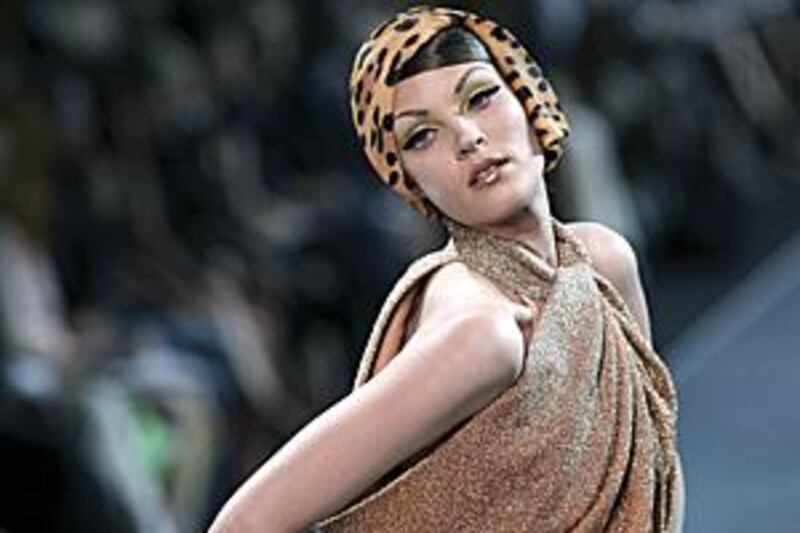What is haute couture? As the shows begin today in Paris, kicking off with the up-and-coming designer Alexis Mabille, it is worth revisiting the definition of this much misused moniker. To be found plastered across tailoring and dressmaking shops across the UAE and the world, and even used on perfumes and jewellery, haute couture is used to add a glow of prestige to the most mundane items. But in fact it is a term that is protected by law, and its fashion designers must conform to strict rules set down by the Chambre Syndicale de la Haute Couture - something that very few companies can afford to be involved with. Every so often one of the major fashion houses drops off the haute couture calendar, as in 2002, when the late Yves Saint Laurent retired, closing the couture house and leaving only the pret-a-porter, to be designed by Stefano Pilati. It shocked those who follow the couture seasons and prompted fearful predictions of the demise of the discipline. And what a discipline it is: the bearers of the Chambre Syndicale de la Haute Couture seal of approval, who are named in an annual decree by the French Ministry of Industry, must retain a Paris atelier of at least 15 employees; must design made-to-measure clothes for their private clients, with multiple fittings; and must show their collections twice a year on the official schedule. Doesn't sound too bad, until you realise that this is in addition to the regular ready-to-wear collections, which have much higher profit margins and a wider audience. Haute couture defines luxury because its very labour-intensiveness prohibits all but the very wealthiest from buying. Certainly, most of us in the Emirates, at a push, can dip into the pret-a-porter treasure boxes that are Saks Fifth Avenue or Harvey Nichols. Made-to-measure fashion is a relatively common and affordable experience here, too. Hand-beading, multiple fittings and extravagant shapes are easily found at some of the more upmarket dressmakers.
But the specialised craftspeople in Paris - les petites mains - who are employed to create innovative, exquisite work ranging from hand-embroidery to silk flowers to shoemaking and millinery are a far cry from the back room beaders. Rather than being seen as mere artisans, these uniquely talented people are cherished as artists and treated accordingly. If you are the very best silk flower maker in the Paris, then you are the very best in the world, and irreplaceable. That level of craftsmanship is available in very few parts of the world, and even in those spots the emphasis is more on the perfection of tradition than on the innovation that goes on in these ateliers. So adored are they that Chanel bought six of the oldest ateliers to help keep them open, and puts on an annual collection, Les Metiers d'Art, to showcase their talents. It's understandable, then, that in straitened times designers may baulk at the extra pressure and expense that couture requires. So why do they do it? It's not for the money, that much is certain. Jean Paul Gaultier has in the past admitted that it cuts into his profits, but that he does it for love - for the chance to truly go wild with fashion, rather than thinking too carefully about what the department stores will want to buy for their customers around the world. And, of course, in the minds of the perfume-buying public, Jean Paul Gaultier is couture. Similarly, what is Dior the brand without those swathes of satin and sculptural, perfectly tailored gowns? It's the fantasy of couture that we buy into when we purchase J'Adore by Dior or Chanel No 5 - and that's what keeps the sales buoyant, too. In recent years, couture seems to have had a little more bounce to it. The traditional couture customers in America and Europe may be taking some hits at the moment, but opening markets in the East and Russia helped couture sales at Chanel to increase 20 per cent last year. New names are added to the roster every season, from the up-and-coming Invited Members of the Chambre, who on the basis of their talent are given the chance to show with the likes of Lacroix and Valentino, to the newest official couturier, Stéphane Rolland, who was welcomed into the fold last month. Luxury, it seems, will be redefined by the current recession, with customers less willing to pay premium prices for designer goods made in factories in Taiwan. But when it comes to the luxury of a bag handcrafted by a properly paid artisan in Italy or an intricately tailored one-off, made-to-measure gown embroidered in Paris, the thousand or so people in the world who can afford it will continue to buy. The death of haute couture has been proclaimed many times but reports of its demise are, as they say, greatly exaggerated.





